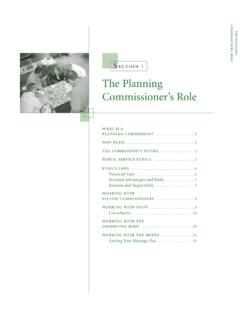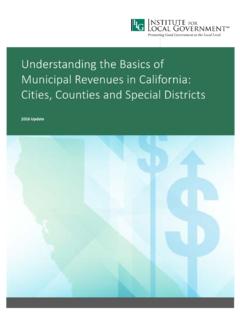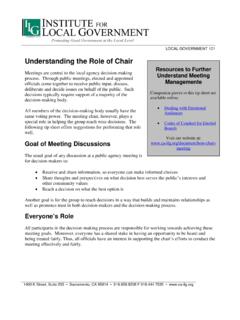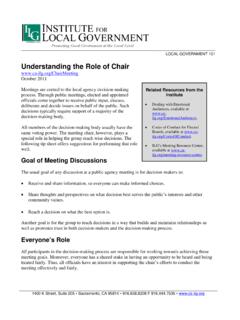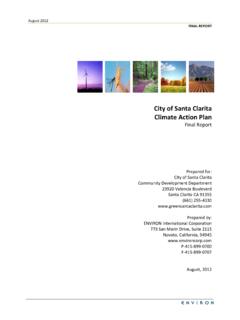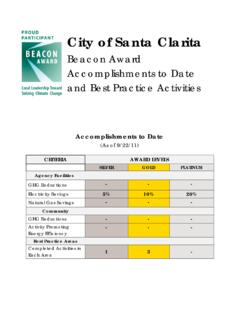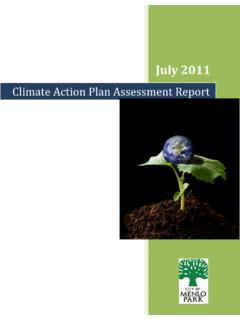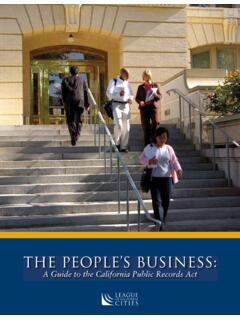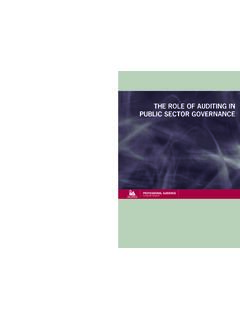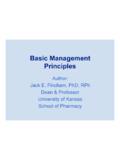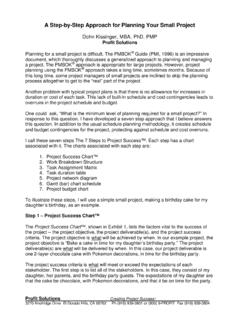Transcription of Understanding the Basics of LAND - Institute for Local ...
1 Understanding the Basics of USE ANDLANDPLANNINGG uide to Local PlanningThe Institute is grateful to the following firms for their support for the Land Use and Environment program:Special thanks to the following individuals whose time and effort contributed to this publication:Tom Brown, Attorney, Hanson BridgettKathy Garcia, Principal, Wallace Roberts & Todd Holzem, project Manager, Mintier Harnish planning ConsultantsMarco Martinez, Attorney, Best Best & Kreiger, LLPR obert E. Murphy, Attorney, Kronick, Moskovitz, Tiedemann & GirardRobert Sherry, planning Director, County of SacramentoWendy Strimling, Deputy County Counsel, County of MontereyEric Vail, Attorney, Burke Williams & Sorensen, LLPAl Zelinka, planning Manager, City of FullertonAll decisions regarding the final content of this guide were made by the Institute for Local GovernmentAdditional thanks to Bill Higgins, Senior Staff Attorney for the League of California Cities and former director of the Institute s Land Use Program.
2 For his role in preparing the 2004 edition of the planning Commissioners Handbook upon which some of the material in this guide is based. Prepared by the Land Use and Environment Program, Steve Sanders, DirectorRemember to always consult a knowledgeable attorney when confronted by legal support for this publication provided through a grant from The California Endowment to the Institute s Healthy Neighborhoods project . Understanding THE Basics oF LAND USE AND planning : Guide to Local planning 2010 by The Institute for Local Government1400 K Street, Suite 205 Sacramento, CA 95814(916) 658-8208 FAX (916) 444-7535 ThE Basics ofLAND USE AND planning gUIdE To Local PLannIngaboUT ThIs gUIdE.
3 1 planning a Process and Profession ..2 The Local planning Framework ..3 Why PLan? ..4 ParTIcIPanTs In ThE Land UsE dEcIsIon-MakIng ProcEss ..7 The Role of Local Officials in planning ..7 City Council Members and County Supervisors ..9 The planning Commission ..9 Other Local planning Bodies and Officials ..10 The Role of the Public ..11 ThE gEnEraL PLan ..13 Mandatory Elements ..14optional Elements ..15 Consistency Requirements ..16 Relationship of the General Plan to other Local Plans ..17 Amending the General Plan ..18 Updating the General Plan.
4 18 Implementation and Follow-Through ..19 Effects of a Deficient General Plan ..20 ZonIng ..21 Zoning ordinances ..22 Conditional Use Permits ..24 Variances ..24 Floating and overlay Zones ..25 Planned Unit Developments ..25 Nonconforming Uses ..26sUbdIvIsIons ..27 Institute for Local GovernmentdEsIgn rEvIEW ..29 EnvIronMEnTaL rEvIEW ..31 Determining the Level of Review ..32 The Environmental Impact Report ..33 Certifying the Environmental Document ..35 Findings ..36dEvELoPMEnT agrEEMEnTs ..37dEdIcaTIons and fEEs ..39 EMErgIng ToPIcs In Local planning .
5 41 Health and the Built Environment ..42 Land Use and Climate Change ..45 ManagIng ThE rIsk of Land UsE LITIgaTIon ..51 Fair Process ..52 Takings ..54A Starting Point for Fairness and Predictability ..55 EndnoTEs ..59rEsoUrcEs for fUrThEr InforMaTIon ..67 General Websites ..67 Publications .. Understanding the Basics of Land Use and planning : Guide to Local planning 1 About This GuideCounty and city officials have many responsibilities. Among the most important is determining how the physical configuration of their communities will change, develop and adapt to meet the present and future needs of their residents.
6 Communities guide their physical growth and development through Local planning . planning covers a broad spectrum of activities, ranging from new development on vacant land, to adaptation of existing structures for new uses, to more sweeping redevelopment of individual parcels and whole neighborhoods with new buildings and facilities. This guide is designed to provide a basic overview of the planning process for Local elected and appointed officials and the general public. The guide describes the typical participants in the planning process and the major plans and policies that comprise the framework of Local planning .
7 Following the description of the planning framework, the guide presents some of the emerging issues in Local planning , and outlines important legal issues that Local officials should consider when they make land use and planning decisions. The tab divider that accompanies the guide presents the nuts and bolts of the process of reviewing a typical application for development. Resources to learn more about particular topics are highlighted throughout the guide. The endnotes include information on important legal citations and other references for those who wish to explore issues in more Institute for Local GovernmentThE PoWEr To PLanLocal agencies derive their authority to shape their communities through planning and land use from the police power.
8 1 The source of this power is both the federal and California constitutions. The police power is broad and elastic and entitles cities and counties to take actions to protect the public s general health, safety, and welfare. However, in most cases Local regulations may not conflict with overriding state authority to regulate land use can expand to meet the changing conditions or priorities of society. Thus, actions that might not have been thought of as part of the general welfare a century ago (for example, curbing sprawl or promoting affordable housing) can fall within its purview Courts have found that a wide variety of Local concerns fall within this authority, including maintaining socio-economic balance, aesthetic values, property values, residential character, and growth a Process and ProfessionPlanning, at its most fundamental level, refers both to a process and a profession.
9 Local officials and residents use a collaborative process to determine the location, character, level and intensity of development that will be permitted or encouraged throughout their community, as well as the areas to be conserved and protected from development. planning is also a professional discipline, whose practitioners possess technical information, analytical tools and problem-solving approaches informed by both research and practice. Understanding the Basics of Land Use and planning : Guide to Local planning 3 The Local planning framework Cities and counties, when they plan, need to be able to consider a range of issues, from the big picture issues of how the community as a whole should grow and develop to the fine details of how particular buildings and facilities will fit in with other uses that share space on a neighborhood street.
10 Different planning tools have been developed to address the unique issues and considerations that occur at each of these levels. Taken together, these tools comprise a framework of Local planning that officials can draw upon to manage the development and realize the collective vision for the future of their community and its residents. The planning framework works along a continuum depending on the scope and focus of a particular set of decisions. planning guides decisions for a region, a community, a particular neighborhood or district, a particular development site and its adjacent uses, or the specific details of building materials and design for a proposed project .
